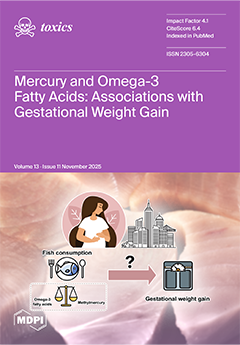Prenatal ozone (O
3) exposure may trigger systemic inflammation and oxidative stress. These effects could contribute to adverse pregnancy outcomes. We conducted a prospective cohort study involving 235 pregnant women in Ningxia, China. Maternal O
3 exposure during pregnancy and prior to conception was assessed using high-resolution spatiotemporal models. Multivariable logistic and linear regression analyses were employed to evaluate the associations between O
3 exposure and adverse pregnancy outcomes. Mediation and interaction models were further applied to examine the potential modifying roles of gestational diabetes mellitus (GDM) and inflammatory biomarkers. In multivariable analyses adjusted for maternal and environmental covariates, higher prenatal O
3 exposure was significantly associated with an increased risk of preterm birth (PTB) (OR = 1.24, 95% CI: 1.05~1.45,
p = 0.010) and low birth weight (LBW) (OR = 1.29, 95% CI: 1.09~1.54,
p = 0.004). Similarly, elevated maternal SAA and CRP levels were positively associated with these adverse pregnancy outcomes (
p < 0.05). Notably, higher TNF-α levels were inversely associated with the risks of PTB (OR = 0.15, 95% CI: 0.03~0.85,
p = 0.032) and LBW (OR = 0.05, 95% CI: 0.01~0.39,
p = 0.005). IL-17A levels were inversely associated with neonatal length-for-age Z scores (β = −0.28, 95% CI: −0.55~−0.01,
p = 0.043). Our findings suggest that prenatal O
3 exposure is associated with increased risks of PTB and LBW. Alterations in systemic inflammatory markers and metabolic dysfunction during pregnancy were related to adverse pregnancy outcomes and fetal growth deficits, but they did not mediate these associations, with O
3 remaining an independent predictor after adjustment.
Full article






